List of Parliamentary constituencies in County Durham
The unitary authorities of Durham and Borough of Darlington are combined for the purpose of parliamentary constituency boundaries, being divided into 7 Parliamentary constituencies– 1 borough constituency and 6 county constituencies. Since the 2019 general election, 4 parliamentary seats are controlled by the Conservative Party and 3 by the Labour Party. Between 1992 and 2019, all 7 seats were held by the Labour Party. With the exception of Darlington, all seats in the current ceremonial county or their predecessors had returned Labour MPs since 1935.
Constituencies
| Constituency[nb 1] | Electorate[1] | Majority[2][nb 2] | Member of Parliament[2] | Nearest opposition[2] | Electoral wards[3][4] | Map | ||
|---|---|---|---|---|---|---|---|---|
| Bishop Auckland CC | 68,170 | 7,962 | Dehenna Davison† | Helen Goodman‡ | Durham County Council: Barnard Castle East, Barnard Castle North, Barnard Castle West, Bishop Auckland Town, Barningham and Ovington, Byerley, Cockfield, Cockton Hill, Cotherstone with Lartington, Coundon, Dene Valley, Eggleston, Escomb, Etherley, Evenwood, Gainford and Winston, Greta, Hamsterley and South Bedburn, Henknowle, Ingleton, Lynesack, Low Spennymoor and Tudhoe Grange, Middlestone, Middleton-in-Teesdale, Ramshaw and Lands, Romaldkirk, Spennymoor, Startforth, Streatlam and Whorlton, Sunnydale, Thickley, Tudhoe, West Auckland, Woodhouse Close. |  | ||
| City of Durham CC | 71,271 | 5,025 | Mary Foy‡ | William Morgan† | Durham County Council: Bearpark and Witton Gilbert, Belmont, Brancepeth, Langley Moor and Meadowfield, Brandon, Carrville and Gilesgate Moor, Cassop-cum-Quarrington, Coxhoe, Crossgate and Framwelgate, Deerness, Elvet, Framwellgate Moor, Neville’s Cross, New Brancepeth and Ushaw Moor, Newton Hall North, Newton Hall South, Pelaw and Gilesgate, Pittington and West Rainton, St Nicholas, Shadforth and Sherburn, Shincliffe. |  | ||
| Darlington BC | 66,397 | 3,294 | Peter Gibson† | Jenny Chapman‡ | Darlington Borough Council: Bank Top, Central, Cockerton East, Cockerton West, College, Eastbourne, Faverdale, Harrowgate Hill, Haughton East, Haughton North, Haughton West, Hummersknott, Lascelles, Lingfield, Mowden, Northgate, North Road, Park East, Park West, Pierremont. |  | ||
| Easington CC | 61,182 | 6,581 | Grahame Morris‡ | Clare Ambrosino† | Durham County Council: Acre Rigg, Blackhalls, Dawdon, Dene House, Deneside, Easington Colliery, Easington Village and South Hetton, Eden Hill, Haswell and Shotton, Horden North, Horden South, Howletch, Hutton Henry, Murton East, Murton West, Passfield,
Seaham Harbour, Seaham North. |
 | ||
| North Durham CC | 66,796 | 4,742 | Kevan Jones‡ | Ed Parson† | Durham County Council: Annfield Plain, Bournmoor, Catchgate, Chester Central, Chester East, Chester North, Chester South, Chester West, Craghead and South Stanley, Edmondsley and Waldridge, Grange Villa and West Pelton, Havannah, Kimblesworth and Plawsworth, Lumley, North Lodge, Ouston, Pelton, Pelton Fell, Sacriston, South Moor, Stanley Hall, Tanfield, Urpeth. |  | ||
| North West Durham CC | 72,166 | 1,144 | Richard Holden† | Laura Pidcock‡ | Durham County Council: Benfieldside, Blackhill, Burnhope, Burnopfield, Castleside, Consett East, Consett North, Consett South, Cornsay, Crook North, Crook South, Delves Lane, Dipton, Ebchester and Medomsley, Esh, Howden, Hunwick, Lanchester, Leadgate, St John’s Chapel, Stanhope, Tow Law and Stanley, Wheatbottom and Helmington Row, Willington Central, Willington West End, Wolsingham and Witton-le-Wear. |  | ||
| Sedgefield CC | 64,325 | 4,513 | Paul Howell† | Phil Wilson‡ | Durham County Council: Bishop Middleham and Cornforth, Broom, Chilton, Ferryhill, Fishburn and Old Trimdon, Greenfield Middridge, Neville and Simpasture, New Trimdon and Trimdon Grange, Sedgefield, Shafto St Marys, Thornley and Wheatley Hill, West, Wingate, Woodham. Darlington Borough Council: Heighington and Coniscliffe, Hurworth, Middleton St George, Sadberge and Whessoe. |  | ||
Boundary changes
The Boundary Commission for England decided to retain these 7 constituencies for the 2010 election, with minor changes to realign constituency boundaries with the boundaries of current local government wards, and to reduce electoral disparity.
| Name | Pre-2010 Boundaries | Post-2010 Boundaries |
|---|---|---|
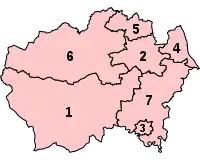 Parliamentary constituencies in Durham |
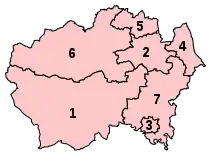 Proposed Revision | |
Proposed boundary changes
The Boundary Commission for England submitted their final proposals in respect of the Sixth Periodic Review of Westminster Constituencies (the 2018 review) in September 2018. Although the proposals were immediately laid before Parliament they were not brought forward by the Government for approval. Accordingly, they did not come into effect for the 2019 election which took place on 12 December 2019, and which was contested using the constituency boundaries in place since 2010.
Under the terms of the Parliamentary Voting System and Constituencies Act 2011, the Sixth Review was based on reducing the total number of MPs from 650 to 600 and a strict electoral parity requirement that the electorate of all constituencies should be within a range of 5% either side of the electoral quota.
On 24 March 2020, the Minister of State for the Cabinet Office, Chloe Smith, issued a written statement to Parliament setting out the Government's thinking with regard to parliamentary boundaries.[5] Subsequently, the Parliamentary Constituencies Act 2020[6] was passed into law on 14 December 2020. This formally removed the duty to implement the 2018 review and set out the framework for future boundary reviews. The Act provided that the number of constituencies should remain at the current level of 650, rather than being reduced to 600, while retaining the requirement that the electorate should be no more than +/- 5% from the electoral quota.
The Act specified that the next review should be completed no later than 1 July 2023 and the Boundary Commission formally launched the 2023 Review on 5 January 2021.[7] See 2023 Periodic Review of Westminster constituencies for further details.
Results history
Primary data source: House of Commons research briefing - General election results from 1918 to 2019[8]
2019
The number of votes cast for each political party who fielded candidates in constituencies comprising Durham in the 2019 general election were as follows:
| Party | Votes | % | Change from 2017 | Seats | Change from 2017 |
|---|---|---|---|---|---|
| Conservative | 123,112 | 40.6% | 4 | ||
| Labour | 122,547 | 40.4% | 3 | ||
| Brexit | 25,444 | 8.4% | new | 0 | 0 |
| Liberal Democrats | 21,356 | 7.0% | 0 | 0 | |
| Greens | 5,985 | 2.0% | 0 | 0 | |
| Others | 4,725 | 1.6% | 0 | 0 | |
| Total | 303,169 | 100.0 | 7 |
Percentage votes
| Election year | 1983 | 1987 | 1992 | 1997 | 2001 | 2005 | 2010 | 2015 | 2017 | 2019 |
|---|---|---|---|---|---|---|---|---|---|---|
| Conservative | 30.4 | 28.3 | 28.4 | 17.6 | 20.6 | 16.6 | 21.4 | 25.4 | 35.3 | 40.6 |
| Labour | 45.5 | 52.0 | 57.1 | 68.5 | 62.7 | 56.3 | 45.3 | 48.5 | 54.6 | 40.4 |
| Liberal Democrat1 | 23.9 | 19.7 | 14.2 | 9.7 | 14.2 | 21.3 | 24.1 | 6.0 | 4.5 | 7.0 |
| Green Party | - | * | * | * | * | * | - | 3.7 | 1.0 | 2.0 |
| UKIP | - | - | - | * | * | * | 3.1 | 15.7 | 3.4 | * |
| Brexit Party | - | - | - | - | - | - | - | - | - | 8.4 |
| Other | 0.1 | - | 0.3 | 4.2 | 2.5 | 5.8 | 6.2 | 0.7 | 1.2 | 1.6 |
11983 & 1987 - SDP-Liberal Alliance
* Included in Other
Seats
| Election year | 1983 | 1987 | 1992 | 1997 | 2001 | 2005 | 2010 | 2015 | 2017 | 2019 |
|---|---|---|---|---|---|---|---|---|---|---|
| Conservative | 1 | 1 | 0 | 0 | 0 | 0 | 0 | 0 | 0 | 4 |
| Labour | 6 | 6 | 7 | 7 | 7 | 7 | 7 | 7 | 7 | 3 |
| Total | 7 | 7 | 7 | 7 | 7 | 7 | 7 | 7 | 7 | 7 |
Maps
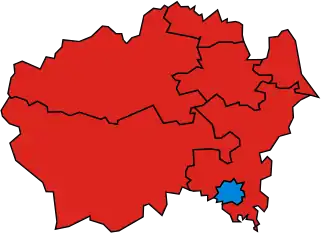 1983
1983 1987
1987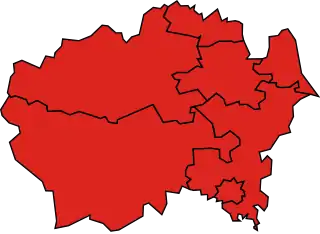 1992
1992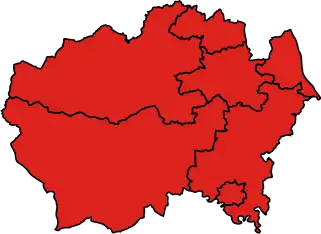 1997
1997 2001
2001 2005
2005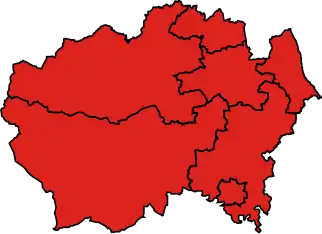 2010
2010 2015
2015 2017
2017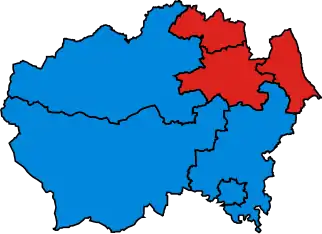 2019
2019
Historical results by party
A cell marked → (with a different colour background to the preceding cell) indicates that the previous MP continued to sit under a new party name.
1885 to 1918
Conservative Independent Conservative Independent Labour Labour Liberal Liberal-Labour Liberal Unionist
| Constituency | 1885 | 1886 | 88 | 90 | 91 | 1892 | 93 | 1895 | 98 | 1900 | 03 | 04 | 1906 | 07 | Jan 10 | 10 | Dec 10 | 12 | 13 | 14 | 15 | 16 | 17 | 18 |
|---|---|---|---|---|---|---|---|---|---|---|---|---|---|---|---|---|---|---|---|---|---|---|---|---|
| Bishop Auckland | Paulton | Havelock-Allan | ||||||||||||||||||||||
| Durham North West | Atherley-Jones | Williams | ||||||||||||||||||||||
| Durham Mid | Crawford | Wilson | Galbraith | |||||||||||||||||||||
| Darlington | Fry | A. Pease | H. Pease | Lincoln | H. Pease | → | ||||||||||||||||||
| Durham | Milvain | Fowler | Elliot | Hills | → | |||||||||||||||||||
| Durham South East | Havelock-Allan | Havelock-Allan | Richardson | Havelock-Allan | Richardson | Lambton | Hayward | |||||||||||||||||
| Barnard Castle | J. Pease | Henderson | ||||||||||||||||||||||
| Chester-le-Street | Joicey | Taylor | → | |||||||||||||||||||||
| The Hartlepools | Richardson | Richardson | C. Furness | Richardson | C. Furness | S. Furness1 | Runciman | |||||||||||||||||
| Gateshead | James | Allan | Johnson | Elverston | ||||||||||||||||||||
| Jarrow | C. Palmer | Curran | G. Palmer | |||||||||||||||||||||
| South Shields | Stevenson | Robson | Rea | Cochrane | Wilson | |||||||||||||||||||
| Houghton-le-Spring | Wilson | Wood | Fenwick | Cameron | Wing | |||||||||||||||||||
| Stockton-on-Tees | Dodds | Davey | Wrightson | Samuel | Ropner | Samuel | Watson | |||||||||||||||||
| Sunderland | Gourley | Pemberton | Stuart | Storey | Greenwood | |||||||||||||||||||
| Storey | Doxford | Summerbell | Knott | Goldstone | ||||||||||||||||||||
1victor in January 1910, Christopher Furness, declared void. Fresh by-election held June 1910, won by Stephen Furness.
1918 to 1950
Coalition Liberal (1918-22) / National Liberal (1922-23) Conservative Labour Independent Group (1949) / Independent Labour (1949-50) Labour Liberal National Labour National Liberal (1931-68)
1950 to 1983
Conservative Labour Social Democratic
| Constituency | 1950 | 1951 | 53 | 1955 | 55 | 56 | 1959 | 62 | 1964 | 1966 | 1970 | 73 | Feb 74 | Oct 74 | 1979 | 1981 | 83 | Status in April 1974 reform |
|---|---|---|---|---|---|---|---|---|---|---|---|---|---|---|---|---|---|---|
| Bishop Auckland | Dalton | Boyden | Foster | Remained | ||||||||||||||
| Blaydon | Whiteley | Woof | McWilliam | Transferred to Tyne and Wear | ||||||||||||||
| Chester-le-Street | Bartley | Pentland | Radice | Part was transferred to Tyne and Wear | ||||||||||||||
| Consett | Glanville | Stones | Watkins | Remained | ||||||||||||||
| Durham | Grey | Hughes | Remained | |||||||||||||||
| Durham North West | Murray | Ainsley | E. Armstrong | Remained | ||||||||||||||
| Easington | Shinwell | Dormand | Remained | |||||||||||||||
| Gateshead East | Moody | Conlan | Transferred to Tyne and Wear | |||||||||||||||
| Houghton-le-Spring | Blyton | Urwin | Transferred to Tyne and Wear | |||||||||||||||
| Jarrow | Fernyhough | Dixon | Transferred to Tyne and Wear | |||||||||||||||
| Sedgefield | Slater | Reed | Abolished Feb 1974 | |||||||||||||||
| South Shields | Chuter Ede | Blenkinsop | Clark | Transferred to Tyne and Wear | ||||||||||||||
| Sunderland North | Willey | Transferred to Tyne and Wear | ||||||||||||||||
| Gateshead West | Hall | Randall | Horam | → | Transferred to Tyne and Wear | |||||||||||||
| Stockton-on-Tees | Chetwynd | Rodgers | → | Transferred to Cleveland | ||||||||||||||
| The Hartlepools | Jones | Kerans | Leadbitter | Transferred to Cleveland, named Hartlepool from Feb 1974 | ||||||||||||||
| Sunderland South | Ewart | Williams | Bagier | Transferred to Tyne and Wear | ||||||||||||||
| Darlington | Hardman | Graham | Bourne-Arton | Fletcher | O'Brien | Remained | ||||||||||||
1983 to present
| Constituency | 1983 | 1987 | 1992 | 1997 | 2001 | 2005 | 07 | 2010 | 2015 | 2017 | 2019 |
|---|---|---|---|---|---|---|---|---|---|---|---|
| Bishop Auckland | Foster | Goodman | Davison | ||||||||
| City of Durham | Hughes | Steinberg | Blackman-Woods | Foy | |||||||
| Easington | Dormand | Cummings | Morris | ||||||||
| North Durham | Radice | Jones | |||||||||
| North West Durham | E. Armstrong | H. Armstrong | Glass | Pidcock | Holden | ||||||
| Sedgefield | Blair | Wilson | Howell | ||||||||
| Darlington | Fallon | Milburn | Chapman | Gibson | |||||||
See also
Notes
- BC denotes borough constituency, CC denotes county constituency.
- The majority is the number of votes the winning candidate receives more than their nearest rival.
References
- Baker, Carl; Uberoi, Elise; Cracknell, Richard (28 January 2020). "General Election 2019: full results and analysis". Cite journal requires
|journal=(help) - "Constituencies A-Z - Election 2019". BBC News. Retrieved 23 April 2020.
- "The Parliamentary Constituencies (England) Order 2007, page 4". Office of Public Sector Information. Crown copyright. 13 June 2007. Retrieved 7 November 2009.
- Boundary Commission for England pp. 1004–1007
- "Update: Strengthening Democracy:Written statement - HCWS183". UK Parliament. Retrieved 20 April 2020.
- "Parliamentary Constituencies Act 2020".
- "2023 Review launched | Boundary Commission for England". Retrieved 8 January 2021.
- Watson, Christopher; Uberoi, Elise; Loft, Philip (17 April 2020). "General election results from 1918 to 2019". Cite journal requires
|journal=(help)